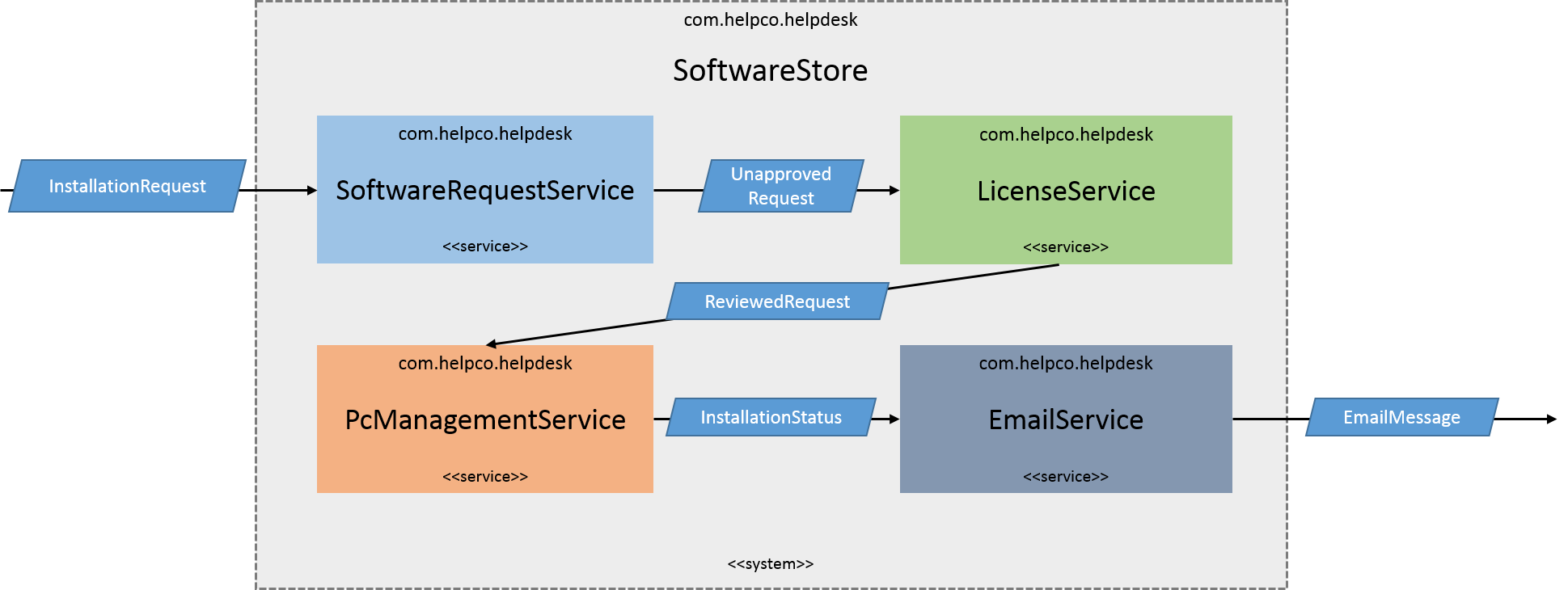Ch. 2 A Simple Software Store System
We’ll reference a simple example system throughout the next several chapters. We use this example as we explore how Jellyfish works.
This example is a “Software Store” system. This system allows users to request a new application be installed on their PC. The system verifies the request, performs the installation, and then notifies the user of the status of the request. It might look something like this:

This system has the following components:
- SoftwareRequestService: This service receives an initial request, verifies the request is valid, and then forwards the request with additional info to the rest of the system.
- LicenseService: This service verifies the license for the actual software is available and all requirements to install the service are met.
- PcManagementService: This service performs the actual installation of the requested software onto a user’s PC.
- EmailService: This service generates emails and notifies requesters of updates to their requests.
Using the System Descriptor (SD) language, we might model each component like so:
SoftwareRequestService.sd
package com.helpco.helpdesk
import com.helpco.helpdesk.datatype.InstallationRequest
import com.helpco.helpdesk.datatype.UnapprovedRequest
model SoftwareRequestService {
input {
InstallationRequest installationRequest
}
output {
UnapprovedRequest unapprovedRequest
}
scenario processRequest {
when receiving installationRequest
then willPublish unapprovedRequest
}
}
LicenseService.sd
package com.helpco.helpdesk
import com.helpco.helpdesk.datatype.UnapprovedRequest
import com.helpco.helpdesk.datatype.ReviewedRequest
model LicenseService {
input {
UnapprovedRequest unapprovedRequest
}
output {
ReviewedRequest reviewedRequest
}
scenario reviewRequest {
when receiving unapprovedRequest
then willPublish reviewedRequest
}
}
PcManagementService.sd
package com.helpco.helpdesk
import com.helpco.helpdesk.datatype.ReviewedRequest
import com.helpco.helpdesk.datatype.InstallationStatus
model PcManagementService {
input {
ReviewedRequest reviewedRequest
}
output {
InstallationStatus installationStatus
}
scenario performInstallation {
when receiving reviewedRequest
then willPublish installationStatus
}
}
EmailService.sd
package com.helpco.helpdesk
import com.helpco.helpdesk.datatype.InstallationStatus
import com.helpco.helpdesk.datatype.EmailMessage
model EmailService {
input {
InstallationStatus installationStatus
}
output {
EmailMessage emailMessage
}
scenario notifyRequestorOfStatus {
when receiving installationStatus
then willPublish emailMessage
}
}
Finally, the top level model for the entire system might look like this:
SoftwareStore.sd
package com.helpco.helpdesk
import com.helpco.helpdesk.datatype.InstallationRequest
import com.helpco.helpdesk.datatype.EmailMessage
import com.helpco.helpdesk.SoftwareRequestService
import com.helpco.helpdesk.LicenseService
import com.helpco.helpdesk.PcManagementService
import com.helpco.helpdesk.EmailService
model SoftwareStore {
input {
InstallationRequest installationRequest
}
output {
EmailMessage emailMessage
}
scenario handleInstallationRequest {
when receiving installationRequest
then willPublish emailMessage
}
parts {
SoftwareRequestService softwareRequestService
LicenseService licenseService
PcManagementService pcManagementService
EmailService emailService
}
links {
link installationRequest -> softwareRequestService.installationRequest
link emailService.emailMessage -> emailMessage
link softwareRequestService.unapprovedRequest -> licenseService.unapprovedRequest
link licenseService.reviewedRequest -> pcManagementService.reviewedRequest
link pcManagementService.installationStatus -> emailService.installationStatus
}
}
Note this system as a single input InstallationRequest and a single output EmailMessage.
We’ll omit design of the data types because their actual contents aren’t very important for this example.

